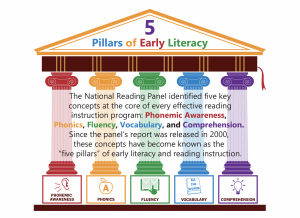Whether you are a parent to a child with a dyslexia diagnosis, a secondary teacher trying to help our students gain foundational skills, or a primary teacher who is new to the idea of structured literacy – here are some terms and words that might be helpful as you navigate this new space. Here are some basics to help you navigate conversations, curricula, and advocacy.
What is Dyslexia?
The International Dyslexia Association defines dyslexia as “A language-based learning disability. Dyslexia refers to a cluster of symptoms that result in people having difficulties with specific language skills, particularly reading. Students with dyslexia usually experience difficulties with other language skills, such as spelling, writing, and pronouncing words. Dyslexia affects individuals throughout their lives; however, its impact can change at different stages in a person’s life. It is referred to as a learning disability because dyslexia can make it very difficult for a student to succeed academically in the typical instructional environment, and in its more severe forms, will qualify a student for special education, special accommodations, or extra support services.”
Another important thing to note about dyslexia is that it affects about 20% of the population and represents about 85% of all learning disabilities.
What is phonemic awareness or phonological awareness? Why is it important for struggling readers?
The simple answer is that phonological awareness is a blanket term that describes the ability to hear and manipulate the sound structure of language. This is where readers work with sounds at the word, syllable, and phoneme levels. Phonological awareness usually begins before a child reaches school and focuses on rhyming, counting syllables, and recognizing how many words are in a sentence. Phonemic awareness is the advanced strand of phonological awareness and focuses on hearing, identifying, and manipulating individual sounds (or phonemes) in spoken words. Before children are able to read, they need to develop an understanding of how sounds work.
Phonemic awareness is vital for struggling readers. According to the National Reading Panel, it is considered to be one of the strongest predictors of reading success. Without understanding sounds or how they work in words, readers will rely on memorization or other strategies to figure out words on a page. This makes reading increasingly difficult as words become more challenging.
What else do readers need to know in order to be successful?
As per the National Reading Panel (2000) findings, the 5 pillars of effective literacy instruction encompass five vital aspects: phonological awareness, phonics, fluency, vocabulary, and comprehension. These elements are connected, working together to strengthen each other.

Phonological Awareness: This involves recognizing and manipulating the sounds of spoken language. It includes skills like identifying rhyming words, breaking words into syllables, and understanding the individual sounds (phonemes) within words.
Phonics: Phonics involves the relationship between sounds (phonemes) and the letters or letter combinations (graphemes) representing those sounds. It teaches individuals how to decode words by understanding the sound-symbol correspondence.
Fluency: Fluency refers to the ability to read with accuracy, speed, and expression. Fluent readers can decode words quickly and effortlessly, allowing them to focus on comprehension and meaning.
Vocabulary: Vocabulary is the set of words that a person understands and uses in their language. A strong vocabulary is crucial for understanding what is read and effectively expressing oneself in writing.
Comprehension: Comprehension is the ultimate goal of reading. It involves understanding and making meaning from written text. Skilled readers can analyze, interpret, and connect ideas presented in the text.
These five pillars are interconnected and essential for developing proficient reading and writing skills. Effective literacy instruction often involves addressing each of these components balanced and systematically.
What is the difference between an evidence-based and research-based curriculum or intervention?
While they are similar in nature, they have subtle differences in their connotations: A research-based curriculum or intervention is one that was developed based on the latest research and scientific theory. So, while it was built on research, the program was not tested independently to evaluate its effectiveness. To call a program or practice evidence-based, researchers must have studied the impact of the program in a controlled setting. Testing and evaluation have been done to prove its effectiveness. Evidence-based programs also must undergo a peer-review process to determine the validity of the findings.
When evaluating curricula or interventions for struggling readers, we want to choose something evidence-based because it’s been proven to work.
Do you think we should add anything to our next installment of the “ABCs of Literacy Acquisition”? Email me at tamara.cella@everyonereading.org and let us know!
Professional Development Opportunities
IMSE’s Comprehensive Orton-Gillingham Plus
Tuition: $1,500
August 14 – 18, 2023 (virtual)
More dates are available at IMSE.com
Course Description: The IMSE Comprehensive Orton-Gillingham Plus Course and Program is 30 hours of a hands-on, interactive, and personalized class that provides a complete understanding of IMSE’s enhanced Orton-Gillingham method, the essential five components to literacy, and the tools necessary to apply it in the classroom. After participating in this accredited Structured Literacy course, teachers will understand the structure and foundation of the English language and the research behind the science of reading. Educators will have a basic knowledge of how to assess and teach students in all three tiers of RTI, as well as students with dyslexia. Participants will evaluate and teach students in phonological skills, phonics/word recognition, spelling, writing, fluency, vocabulary, and comprehension. This course includes an asynchronous component for fluency, vocabulary, and comprehension. The Comprehensive OG Plus course is appropriate for teachers whose students are emergent and beginning readers and readers struggling with word recognition. This course also includes an asynchronous component that shares research and strategies for teaching and assessing fluency, vocabulary, and comprehension. Upon completing this course, teachers can purchase two graduate credits.



